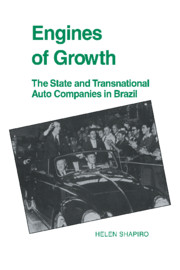Book contents
- Frontmatter
- Contents
- Tables and Figures
- Acknowledgments
- 1 Approaches to State Intervention
- 2 Why Auto?
- 3 The Determinants of Firm Entry
- 4 Rent Redistribution and Linkage Effects
- 5 The Automotive Parts Sector
- 6 Conclusion
- Appendix A Data Exhibits on the Brazilian Auto Industry
- Appendix B José Almeida's Calculation of Subsidies Provided to the Brazilian Automotive Industry
- Index
5 - The Automotive Parts Sector
Published online by Cambridge University Press: 11 September 2009
- Frontmatter
- Contents
- Tables and Figures
- Acknowledgments
- 1 Approaches to State Intervention
- 2 Why Auto?
- 3 The Determinants of Firm Entry
- 4 Rent Redistribution and Linkage Effects
- 5 The Automotive Parts Sector
- 6 Conclusion
- Appendix A Data Exhibits on the Brazilian Auto Industry
- Appendix B José Almeida's Calculation of Subsidies Provided to the Brazilian Automotive Industry
- Index
Summary
The establishment of a Brazilian-owned parts sector was a critical component of the development strategy vis-á-vis the automotive industry. Because of the parts sector's diversity and its lower capital and technological requirements relative to vehicle production, Brazilian planners assumed that local capital could play a significant role in its development. Promoting a nonvertically integrated industry and a Brazilian-controlled parts sector was seen as a means of directing a portion of the rents accruing from protection to domestic capital. The intrasectoral redistribution of resources between transnational corporations (TNCs) and local firms was expected to strengthen the Brazilian industrial sector and to create a basis for further accumulation. A locally controlled parts sector was also used to legitimate foreign dominance of the terminal sector.
This chapter shows, however, that the parts sector effectively came under foreign control, either through vertical integration by the terminal producers or through independent foreign direct investment. With a few notable exceptions, the process generated a bifurcated parts sector: Foreign capital predominated in large, capital- and technology-intensive firms that operated in a relatively concentrated market and sold most of their output to the terminal sector; local capital was centered in the small- and medium-sized firms that produced more standardized parts, faced more competition, and sold a greater portion of their output as replacement parts. The auto program's rapid domestic-content schedule forced terminal firms to work with domestic parts suppliers and initially made them somewhat dependent upon them.
- Type
- Chapter
- Information
- Engines of GrowthThe State and Transnational Auto Companies in Brazil, pp. 191 - 216Publisher: Cambridge University PressPrint publication year: 1994



